Rising to New Depth
There have been jokes and gimmicks and workarounds, but there has never been anything like high-quality, high-definition 3D for Hollywood movies in the home before now. The reality of a major manufacturer's consumer display that offers true 3D--in full 1080p HD--is finally upon us. Samsung has managed bring to market one of the very first 3D HDTVs with their exceptionally well-featured UN55C8000 LED LCD HDTV, the 55-inch model in a line which also includes 46- and 65-inch screen sizes. This 3D TV was reviewed in conjunction with the Samsung BD-C6900 Blu-ray 3D Player, so I'm not spoiling any surprises when I say that 3D in the home can be pretty darned incredible.
The Science of Wicked
Working with the slightly different angles at which our eyes see, owing to the couple of inches between our left and right retinas, the brain ordinarily processes these two images into what we know as 3D, with a sense of depth, in the real world. To simulate this effect on an essentially 2D television, the screen will display two separate but overlapping versions of the same scene simultaneously, also at slightly different angles, one for the left eye, the other for the right. Via a tiny 3D emitter in the front of the TV, these images are synchronized to a pair of Samsung's Active Glasses which is designed to show only the left eye the left part of the image and the right eye the right part of the image. From there, the human brain takes it away to give us the illusion of 3D imagery.
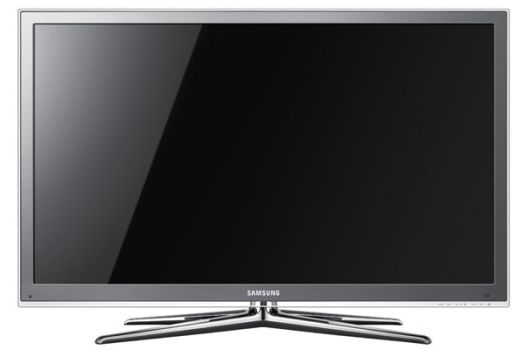
The glasses use an active shutter technique to alternately block the left and right eye 120 times per second (60 times per eye), matched to the corresponding TV images. At this high framerate, the effect appears continuous. Samsung will be offering the glasses in both battery-operated and rechargeable models, although somewhat surprisingly neither is included with the TV. I used one of the two pairs from the optional 3D Starter Kit, powered by an included button-cell battery, and the lightweight plastic frames fit easily and comfortably over my own prescription eyeglasses. It's important to note that, although the glasses are not in the box with the TV, Samsung is offering said 3D Starter kit, which includes the 2 pairs of glasses and a Blu-ray 3D version of "Monsters Vs. Aliens") for free with the purchase of a Samsung 3D TV and Blu-ray 3D player. This offer was recently extended through June 20th, 2010 (more details here).
The C8000 television hardware itself is impressive to the eye even when powered off, another sleek Touch of Color ("titanium" is a color...?) design from Samsung with a substantial transparent frame extending in all four directions and non-button touch controls along the bottom. It's stylish, it's distinctive, but it's also highly reflective, and once I even caught my daughters checking their look in the glass as if it was a 55-inch mirror. Decorator's note: placement across from a window will require window treatments if you like watching TV during daylight hours!
Ironically considering its added dimension of depth, this 3D TV is about as flat as the fluffiest pancake I ever ate, indeed less than an inch thick, owing not merely to the LED backlighting but an excellent edge-lit LED array illuminating the 55-inch liquid crystal display from the sides. The LEDs also offer what Samsung calls Precision Dimming - a variation on local dimming technology that allows the set to reap some of the benefits of local dimming but without the expense and depth of a full array of LED backlights. This use of LED technology, combined with enhancements to the LCD panel itself earn the set an impressive contrast ratio rated by Samsung without a hint of a smirk (by them that is, not us) as "8,000,000:1."
Apparently the TV exceeds current EnergyStar 3.0 guidelines, and periodically it will show us a little meter indicating its power consumption compared to more piggish CCFL-backlit LCDs via an on-screen widget. Despite the edge-lit configuration and serious screen size, the uniformity of the brightness is exceptionally good compared to other edge-lit displays. The letterbox bars above and below the picture while watching cinemascope content can veer a little toward grey, but certainly blacker than a black scene in most movies, and without as much of the bright spotting around edges that we've seen on other more basic edge-lit sets.
Before we delved deep into the set-up menus, the TV's Ambient Light Sensor was active, to automatically adjust overall brightness in response to the room environment. This was a minor issue during our early tests, as we could not explain the sudden, drastic shifts in brightness as editor Chris Boylan and I moved around the TV, switching cables and what-not. In the days that followed, I did not notice this shift again, likely because I was working alone, until some final double-checks with different lights on and more people milling about. Don't want or need an ambient light sensor? Simply go into the Menu, then Mode, to "Eco Solution," to turn of this "Eco Sensor." We can also adjust the TV's Minimum Brightness here on a slider from 0 to 20.
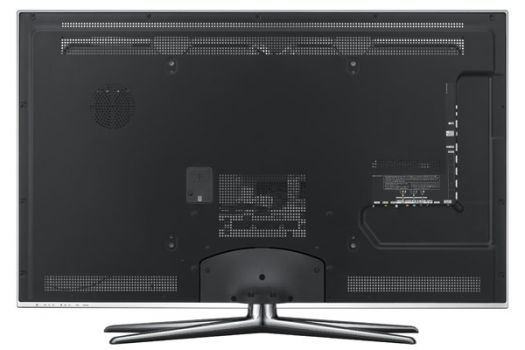
As we found out upon setup, however, one of the UN55C8000's dirty little secrets is the need for input adapters (included, at least) to handle many of the audio/video/data inputs, converting for example the R/G/B RCA-type plugs of component video to a single mini-plug. Apparently even the width of a single RCA plug was considered too costly from a depth perspective, hence the adapters. Among the many perks of industry-standard HDMI: The plug is nice and flat, so it is accepted as-is by the TV, although any HDMI cable used must be 0.55 inches thick or less. I have to wonder too if the two rear-panel USB ports, so handy for a quick photo slideshow or throwing on a little MP3 music or home videos, could not have been placed in a more convenient spot (the side, perhaps) to give easier access to those folks mounting the TV right against the wall. We used the shiny four-footed swivel stand that comes bundled with the TV.
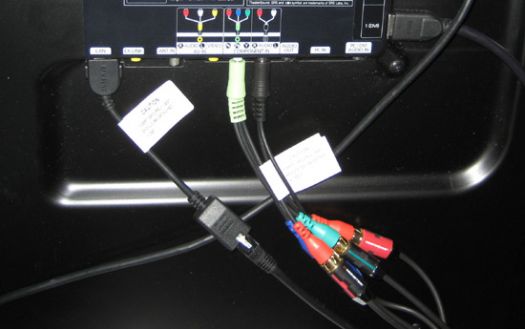
IPTV's Most Wanted
Like the recent Samsung Blu-ray 3D player, the BD-C6900, the UN55C8000 TV comes packing the latest multimedia features. AllShare streams media from a connected Samsung PC or portable device, and the unit features standard DLNA compliance for ease and reliability whilenetworking with other DLNA-compatible computers and network drives. It works wired or wirelessly, although the necessary Samsung LinkStick Wi-Fi adapter is not included. Internet@TV--with its own dedicated button on the remote--is a portal to a host of online applications for the TV. I was immediately pushed updates for the "Samsung Apps" versions of YouTube, Picasa Web Albums, Pandora, APNews and VUDU, with Netflix and Blockbuster video-on-demand options as well, in addition to an assortment of games, plus Facebook and Twitter for the social butterflies.
VUDU allows anyone to access trailers and bonus features immediately, for free, without an account, in standard or high definition, plus their own proprietary best-in-show, "HDX." Each format required about five seconds for the initial buffering, although HDX needed to re-buffer several times during a three-and-a-half-minute clip, no doubt courtesy of a less than stellar internet connection speed. The image quality is spectacular however, and pressing the Info button on the remote during VUDU playback brings up a customized VUDU mini-menu. Very sweet. All of the apps are currently free, altought the streaming services come with their own monthly or per-rental fees. The TV also supports ConnectShare via the two USB ports, to plug in a camera, hard disk drive or thumb drive and enjoy digital music, photos or movies.
Independent of Internet@TV/Samsung Apps, but also with its own special one-button remote access, are Yahoo! TV Widgets, a slicker array of news and entertainment choices with real home theater appeal. There's a TV Guide Widget; an Amazon Video on Demand Widget which can link to an existing account if we have one, after we register the TV via the computer.
Loads of Modes
The UN55C8000 offers a plethora of predetermined viewing modes with a vast depth of customizability as well, to adjust the picture in more ways than we can count. In fact, a recent firmware upgrade which we applied (bringing us up to version 1016.0) added yet another critical picture adjustment, to benefit 3D specifically, but more on that later. For ideal movie viewing, we inevitably settled upon Movie Mode, with a few of our own further tweaks, most notably ratcheting the Sharpness down to 0. Worth noting is that the digital noise filter and edge enhancement were turned off for our critical evals, along with options like the LED Motion Plus strobing backlight.
Samsung's 240Hz Clear Motion Rate technology is onboard, interpolating additional frames in between the "real" input frames, for a total of 240 frames per second. This is intended to bring superior clarity and motion smoothness to fast moving images. Auto Motion Plus adjusts how exactly the TV--after its automatic detection of the native frame rate of the source--converts 24, 30 and 60Hz signals to the 240Hz output of the display. If this feature is turned off, the TV simply outputs everything at appropriate multiples of the input: 24 x 10, 30 x 8 or 60 x 4.
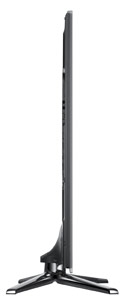
With the Custom adjustments, we can crank up the interpolation for 30/60Hz sources by increasing the "Blur Reduction," while preserving the film frame rate--24 frames repeated ten times for 240 Hz--by sliding the "Judder Reduction" all the way down. The Clear setting is comparable to Blur being set to 10, and Judder at 0 (smooth motion for video, native frame rate and natural look for film), Standard gives some interpolation for both film and video (Blur and Judder set to 5 or so), and Smooth imparts maximum interpolation for both film and video (Blur and Judder both near 100%). We went with full Blur Reduction and no Judder Reduction - hey, what can we say? - we like our 24p film inputs "au naturel."
Our evals were off to a good start with the HQV Benchmark DVD at 480i output over component video, no problem on the Color Bar Test with its tiny white horizontal lines, and smooth gradation in the blue bar. The big white slab of the Diagonal Filter "Jaggies" Test was smooth all the way 'round, the second test (the three shorties) showed only a modest, acceptable quiver on some of the corners, most notably the bottom bar, but the edges per se were crisp. The Flag Test was a pass, a few minor jags but a mostly-clean Star-Spangled Banner, and the bricks in the background building were just a little twitchy. Picture Detail is a slightly grudging thumbs-up, the statue and bridge looked good but I've seen better, and the grass was a little soft, while the stairs began to lose their definition about halfway up. I was impressed by the Noise Reduction, with a clean, stable image of the clouds, trees et. al. Mosquito noise, while present, was minimal. Motion Adaptive Noise Reduction was less successful, with streaky, artifact-ridden roller coaster passengers under mostly clear skies, while I could barely read the name on the back of the pleasure boat in the second scene.
The TV locked onto the Super Speedway clip in the 3:2 Detection test, the moiré went away and didn't come back. As is to be expected, performance varied on the different Film Cadences, but no serious issues here. Up until this point in the HQV DVD tests we had been using the TV's default Film Mode setting for incoming 480i signals, "Auto 1," which detects 3:2 on most program content that was shot at the standard film speed of 24p. The "Film Mixed with Added Video Titles" tests fared poorly at this setting, with the horizontal crawl broken down into crooked lines, and random instants of clean text. The vertical crawl was problematic too, but less so. Fortunately, the TV has a second Film Mode setting, Auto 2, which prioritizes such tricky video-based text overlaid onto film. Auto 2 took a second to lock onto the horizontal crawl, then it was fine, with only slight coiling on the guitar strings in the background, a bit longer locking onto the vertical crawl. During that lock-on period, the image tends to stutter, too. Am I saying that we should go into the menus and switch over to Auto 2 every time video crawls appear? No -- frankly the TV's video processor should be good enough to detect this automatically -- but at least it's there for those advanced image tweakers.
Fed to the TV at 1080i output over HDMI, the HQV Benchmark Blu-ray yielded more detail than I've seen during other gear reviews on the flowers and the sailboat in HD Noise Reduction, but definitely more noise as well, an interesting balance. The fine horizontal lines in the Video Resolution Loss Test were evident with no strobing, but some were almost obscured by fat, dark horizontal bands within the corner squares. High marks for the Diagonal Filter "Jaggies" Test, with only the slightest loss of smoothness on the top edge of the bottom bar, and the single long bar is smooth, like butta'. No strobing per se in the corner boxes of the Film Resolution Loss Test, the moving pattern with the fine horizontal lines, but those dreaded dark horizontal bands return, and a moiré-like motion artifact takes hold in the vertical lines. Meanwhile, the Stadium test showed a buzz and twitch in the upper deck which soon became a faint moiré pattern. So deinterlacing results are mixed at both standard and high definition.
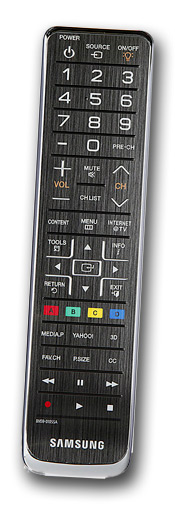
Avatar in 3D... Sort of!
The above average rendering of the distinctively filmic warmth of classics and neo-classics like Blade Runner: The Final Cut and Sleeping Beauty makes for an extremely enjoyable presentation of favorite Blu-rays on the UN55C8000. Standard DVDs such as Gladiator input at 480i look quite clean, with solid detail and a natural overall look as well. While the nuances of the contrast are outstanding here, the effect of the LED precision dimming is not as pronounced as I recall on the Vizio VF551XVT, (which offers full-array backlighting with local dimming) but definitely providing deeper perceived blacks than with precision dimming disabled, and clearly evidenced in areas like the letterboxing bars top and bottom, which are grayer otherwise. With judder left intact on film content (Judder reduction set to 0), I found that there was still a mild smoothing effect on familiar movies, suggesting that there was still some motion interpolation going on. This should not be the case with Judder Reduction set to 0, but this is what I saw. It was almost pleasant, although I remain unindoctrinated on the "benefits" of motion interpolation for 24p film sources. Perhaps the current generation needs to grow up looking at frame-enhanced content to create its own visual baseline...?
[editor's note: Samsung has confirmed that a Judder Reduction setting of "0" does incorrectly produce some motion interpolation on 24p sources. To work around the problem, set Auto Motion Plus (AMP) to OFF, which disables all motion interpolation for both video and film sources. Hopefully this can be corrected via a future firmware upgrade.]
But of course, the main reason to invest the $3,500 in a new 3D TV like this--and a 3D source component like a new Blu-ray player--is to watch true 3D HD content, which is simply stunning. Monsters vs. Aliens on Blu-ray 3D dazzles with its you-are-there sense of realism. I've been roping in every visitor to Rancho Chiarella for a demo, and they are routinely astonished. My mother-in-law even saw past the animation and the fantasy storyline, commenting how believable it all looked. The effect isn't wimpy, either: "Is it 3D? Is it working...?" When it's working, we know. The "B.O.B.'s Big Break" bonus short brings its own unique moments, like a rain of 3D confetti, and some DreamWorks movie trailers are also included in 3D, the only bonus content on this promotional disc.
The TV automatically recognizes true 3D content, but can also be set to perform 3D upconversion of 2D standard- and high-definition video, and even still photos using the same underlying technology. Of course, the results are far superior technically with real 3D content that has been filmed (or generated as the case may be) with true independent left and right eye feeds. Also, artistic choices come into play: choices of what goes where within the scene, whether the foregoround or background are in focus, etc. One of the most common and significant ways 3D benefits movies is the way characters suddenly pop out from their backgrounds, for example imparting a more substantial presence within the viewer's world.
So what happens when you take 2D content and try to render it in 3D in real time? We thought a natural choice for this test would be the Blu-ray version of Avatar. Many assumed Fox would release this as a true Blu-ray 3D disc (compatible with 2D players, of course) in order to promote adoption of the new format, but apparently the studio's position is that the market is not quite there yet, so instead we are treated to a tradiitonal--although admittedly stunning--2D version of the film.
Converting the 2D version of Avatar to 3D via the prowess of the UN55C8000 created an interesting effect, but was not as dramatic as the genuine RealD or IMAX 3D theatrical presentations this past winter. Gone were Cameron's specific, prescribed areas of focus that gave the 3D version its depth. The floating water droplet in an early scene does have some apparent depth to it but is nowhere near the hypnotic, reach-out-and-touch-it simulation that we recall from the theater. The single wood sprite landing on Neytiri's arrow is more impressive, it seems to stand out more in the foreground, but still without the dedicated plane of focus it would display in true 3D. But this presentation did bring back a lot of good memories. Other well-produced "event" motion pictures like The Dark Knight and Star Trek can take on a whole new measure of verisimilitude this way, assuming that we want to wear the active shutter glasses for the duration of our viewing. And yes, even DVDs can benefit from a noticeable 3D enhancement here, meaning that your entire library can look new again. If nothing else it's something to keep you entertained while waiting for further real 3D content to become available.
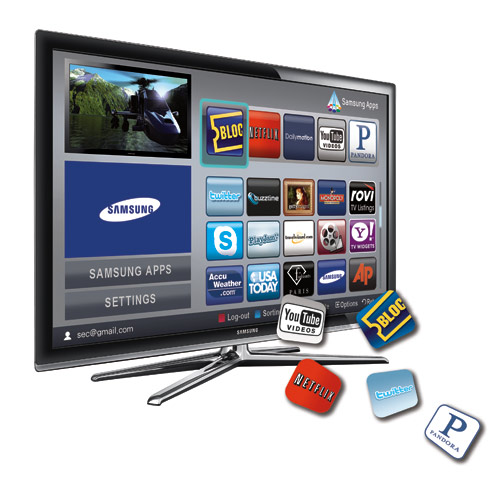
My only issue with the quality of the 3D (both native and generated) was intermittent instance of cross-talk, occasional errors in the would-be seamless processing the left-eye/right-eye images, which can appear as ghosting pretty much anywhere in the frame. New to the TV's bag of tricks via that firmware update I mentioned earlier is the "3D Optimize" control, which can be shifted up or down one notch from its default central position, during which the screen goes black for a second or two. This did make a difference, but so far I've yet to find a way to completely banish the cross-talk.
Turn-Ons:
Turn-Offs:
Final Thoughts
The Yahoo! Widgets for CBS TV and Showtime got me thinking: Right now, Monsters vs. Aliens is one of exactly... one 3D Blu-ray available, and even that is not being sold separately, only as part of the Starter Kit. ESPN is scheduled to broadcast the World Cup as its first 3D event over DirecTV in June, but since this TV is connected to broadband internet anyway, how's about a little 3D content over Ethernet, or even wirelessly? The UN55C8000 is certainly a shining example of the current state of the art in TV features and technology. It can do some amazing things, no doubt, so let's give it something amazing to do. Stat!
Manufacturer's Specifications for Samsung UN55C8000 55-inch 1080p 3D LED HDTV:
Key Features:
Video:
Audio:
Inputs/Outputs:
Weight and Dimensions:
What's in the Box?
Company Contact Information
Samsung Electronics America, Inc.
105 Challenger Road
Ridgefield Park, NJ 07660
ph: 800-SAMSUNG
Website: www.samsung.com
Where to Buy:
| Overall | |
|---|---|
| Value | |
| Performance | |
| Features/Ergonomics |